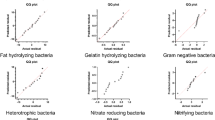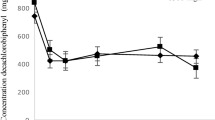Abstract
The population densities of 15 microbial communities in the coconut leaves + cow manure mixture (10:1 ratio, w/w) and pure cow manure, gut contents of the earthworm, Eudrilus sp., reared on the above substrates and vermicompost produced by the worm were studied. The enumeration was done by dilution plate and most probable number method using several selective and semi-selective microbial media. In the vermicompost produced from coconut leaves + cow manure (CLV) mixture, 9 out of 15 microbial communities, particularly the plant beneficial ones, were amplified whereas five communities were amplified in case of pure cow manure (CMV). The CLV contained significantly high population of fungi, free-living nitrogen fixers, phosphate solubilizers, fluorescent pseudomonads, and silicate solubilizers. The CMV was preponderant with aerobic heterotrophic bacteria, actinomycetes, and Trichoderma spp. Spore formers were present in similar numbers in both the vermicomposts. Presence of Azotobacter was detected only in CMV. The results obtained in this study suggest coconut leaf litter to be a good alternative for cow manure for the production of vermicompost, especially in the areas where coconut is grown in plenty.

Similar content being viewed by others
References
Allen ON (1959) Experiments in soil bacteriology, 3rd edn. Burgess, Minneapolis, MN, USA, p 117
Alexander M, Clark FE (1965) Methods for most probable number of Nitrosomonas and Nitrobacter. Methods of soil analysis, Part 2. Soil Sci Soc of America, Madison, USA, pp 1477–1480
Becking JH (1959) Nitrogen fixing bacteria of the genus Beijerinckia in South African soils. Plant Soil 11:193–206
Bunt JS, Rovira AD (1955) Microbiological studies of some subantartic soils. J Soil Sci 6:119–128
Chet I, Baker R (1981) Isolation and biocontrol potential of Trichoderma hamatum from soil naturally suppressive to Rhizoctonia solani. Phytopathol 71:286–290
Chaoui HI, Zibilske LM, Ohno T (2003) Effects of earthworm casts and compost on soil microbial activity and plant nutrient availability. Soil Biol Biochem 35:295–302
Decaens T, Rangel AF, Asakawa N, Thomas RJ (1999) Carbon and nitrogen dynamics in ageing earthworm casts in grass lands of the eastern plains of Colombia. Biol Fertil Soils 30:20–25
Devlee Schanwer D, Lal R (1981) Properties of earthworm casts under secondary tropical forest re-growth. Soil Sci 132:175–181
Drake HL, Horn MA (2007) As the worm turns: the earthworm gut as transient habitat for soil microbial biomes. Ann Rev Microbiol 66:169–189
Edwards CA, Burrows I (1998) The potential of earthworm compost as plant growth media. In: Edwards CA, Neuhauser E (eds) Earthworm in waste and environmental management. SPB Academic Press, Netherlands, pp 21–32
Edwards CA, Fletcher KE (1988) Interactions between earthworms and microorganisms in organic matter breakdown. Agric Ecosyst Environ 24:235–247
Egert M, Marham S, Wagner B, Scheu S, Friedrich MW (2004) Molecular profiling of 16S rRNA genes reveals diet-related difference of microbial communities, gut, and casts of Lumbricus terrestris L (Oligochaeta: Lumbricidae). FEMS Microbiol Ecol 48:187
Gomez KA, Gomez AA (1984) Statistical procedures for agricultural research, 2nd edn. Wiley and Sons, USA, p 680
Gopal M, Gupta A, Thomas GV (2006) Prospects of using Metarhizium anisopliae to check the breeding of insect pest, Oryctes rhinoceros L., in coconut leaf vermicomposting sites. Biores Technol 97:1801–1806
Hand P, Hayes WA, Frankland JC, Satchell JE (1988) The vermicomposting of cow slurry. Pedobiologia 31:199–209
Hankin L, Anagnostakis SL (1977) Solid media containing carboxymethyl–cellulose to detect C x cellulase activity of microorganisms. J Gen Microbiol 6:109–115
Hendriksen NB (1991) Gut load and food retention time in the earthworm Lumbricus festivus and L. castaneus: a field study. Biol Fertil Soils 1:170–173
Kale RD, Mallesh BC, Bano K, Bagyaraj DJ (1992) Influence of vermicompost application on the available macronutrients and selected microbial population in a paddy field. Soil Biol Biochem 24:1317–1320
King EO, Ward MN, Raney DE (1954) Two simple media for the demonstration of pyocyanin and fluorescein. J Lab Clin Med 44:301–307
Krištǖfek V, Ravasz K, Pižl V (1992) Changes in densities of bacteria and microfungi during gut transit in Lumbricus rubellus and Aporrectodea calignosa (Oligochaeta: Lumbricidae). Soil Biol Biochem 24:1499–1500
Martin JP (1950) Use of acid, rose Bengal and streptomycin in the plate method for estimating soil fungi. Soil Sci 69:215–232
Parle JN (1963) Microorganisms in the intestines of earthworms. J Gen Microbiol 31:1–11
Parle JN (1963) A microbiological study of earthworm casts. J Gen Microbiol 31:13–22
Pedersen JC, Hendriksen NB (1993) Effect of passage through the intestinal tract of detrivore earthworms (Lumbricus spp.) on the number of selected gram-negative and total bacteria. Biol Fertil Soils 16:227–232
Pikovskaya RI (1948) Mobilization of phosphorus in soil in connection with vital activity of some soil microbial species. Mikrobiologiya 17:362–370
Prabhu SR, Subramanian P, Bidappa CC, Bopaiah BM (1998) Prospects of improving coconut productivity through vermiculture technologies. Indian Coconut J 29:79–84
Schmidt O, Doube BM, Ryder MH, Killham K (1997) Population dynamics of Pseudomonas corrugata 2140R lux8 in earthworm food and in earthworm casts. Soil Biol Biochem 29:523–528
Schönholzer F, Hahn D, Zarda B, Zeyer J (2002) Automated image analysis and in situ hybridization as tools to study bacterial populations in food resources, gut and cast of Lumbricus terrestris. Lab J Microbial Methods 48:53–68
Scullion J, Goodacre R, Elliott G, Huang W, Worgan H, Gwynn-Jones D, Griffith G, Darby R, Bailey M, Clegg C, Draper J (2004) Food quality and microbial succession in ageing earthworm casts: standard microbial indices and metabolic fingerprinting. Pedobiologia 47:888–894
Subler S, Edwards CA, Metzger J (1998) Comparing vermicomposts and composts. Biocycle 39:63–66
Tomati U, Grapelli A, Galli E (1988) The hormone-like effects of earthworm casts on plant growth. Biol Fertil Soils 5:288–294
Wolter C, Scheu S (1999) Changes in bacterial numbers and hyphal lengths during gut passage through Lumbricus terrestris (Lumbricidae, Oligochaeta). Pedobiologia 43:891–900
Acknowledgments
The authors are grateful to the anonymous reviewers for their constructive comments on the ms.
Author information
Authors and Affiliations
Corresponding author
Rights and permissions
About this article
Cite this article
Gopal, M., Gupta, A., Sunil, E. et al. Amplification of Plant Beneficial Microbial Communities During Conversion of Coconut Leaf Substrate to Vermicompost by Eudrilus sp.. Curr Microbiol 59, 15–20 (2009). https://doi.org/10.1007/s00284-009-9388-9
Received:
Revised:
Accepted:
Published:
Issue Date:
DOI: https://doi.org/10.1007/s00284-009-9388-9




